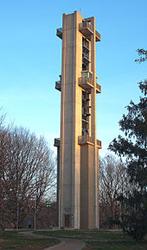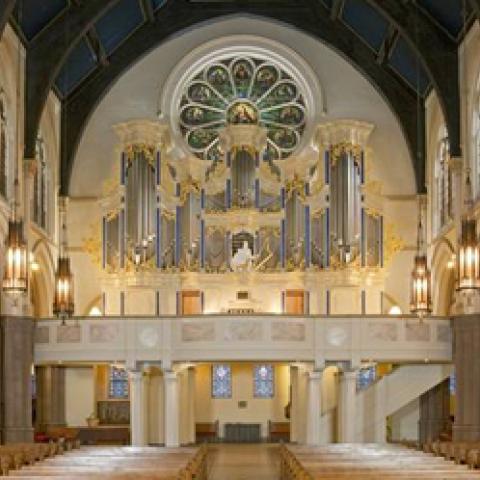February Florida Festival
The 14th International Carillon Festival at Bok Tower Gardens in Lake Wales, Florida, will occur February 20-28, featuring carillonneurs Geert D'hollander, Todd Fair, Ulla Laage, Carlo van Ulft, Milford Myhre and William De Turk. Events include daily 3 pm carillon recitals, a moonlight recital on February 27, lectures and exhibits in the new Education & Visitor Center, and several non-carillon concerts. For more information, contact Bill De Turk, Bok Tower Gardens, 1151 Tower Blvd., Lake Wales, FL 33853-3412; phone: 941/676-1154; fax: 941/676-6770; E-mail: <[email protected]>.
Berkeley Congress Report
The 56th Congress of the Guild of Carillonneurs in North America was held at the University of California at Berkeley, 17-20 June 1998 with 126 persons in attendance. University Carillonneur Geert D'hollander was the host. Held in conjunction with the Fifth Berkeley International Carillon Festival, the 1998 meeting focused on the life and work of Emilien Allard and honored the memory of Ronald Barnes. Madeleine Allard was present as an honored guest. Also honored were Evelyn Chambers and other members of the Class of 1928, patrons of the Berkeley Carillon and its International Carillon Festival.
Recitalists for the Congress were Lisa Lonie of Philadelphia; George Gregory of San Antonio, Texas; Claude Aubin of Montréal, Québec, Canada; Gideon Bodden of The Netherlands; Andrea McCrady of Spokane, Washington; and the carillonneurs of Berkeley: Geert D'hollander, John Agraz, Jeff Davis, David Hunsberger, and Liesbeth Janssens. The Berkeley Brass Quintet conducted by David Milnes joined Geert D'hollander and Liesbeth Janssens in a special program of music arranged for bells and brass by Ms. Janssens. D'hollander gave the premiere performances of the winning pieces in the 1998 Johan Franco Composition Competition. The first prize was awarded to Mr. D'hollander himself for his Modal Nocturne. Ennis Fruhauf's Passacaglia was awarded second prize.
John Agraz gave a workshop on basic carillon maintenance. Masterclasses were taught by John Gouwens on interpretation and by Geert D'hollander on effective ways to learn new music. Two presentations on the music of Emilien Allard were given: Milford Myhre played historic recordings from Bok Tower, and Liesbeth Janssen shared her findings based on theoretical analyses of some of Allard's pieces.
Following successful examination recitals, ten members were accorded Carillonneur status by vote of the Guild: Steven Ball of Ann Arbor, Michigan; Linda Dzuris of Ann Arbor, Michigan; Chuck Barland of Lawrence, Kansas; Andy Greene of Berkeley, California; Andrew Capule of Berkeley, California; Liesbeth Janssens of Berkeley, California; Helena Chen of Berkeley, California; Sabin Levi of Provo, Utah; Geert D'hollander of Berkeley, California; and Lynne Tidwell of Lawrence, Kansas.
Dr. Joseph F. Marsh, Jr., former president of Concord College, and Alicia Porter Washam and Rufus "Buddy" Porter of Highland Park United Methodist Church, Dallas, were recommended and approved for Honorary Membership. Janet Dundore was awarded the Extraordinary Service Award for her many contributions to the Guild and to the profession, most particularly her original, audience-friendly approach to recitals. Emilien Allard, Evelyn Chambers, the Class of 1928, Janet Dundore, and Karel and Linda Keldermans received Berkeley Medals. A memorial fund in the name of Ronald Barnes was established to provide scholarships for North Americans to study the North American Carillon Art in North America.
The next congress of the GCNA will be held at Iowa State University, Ames, 16-19 June 1999. Tin-shi Tan will be our host. In the year 2000, the CGNA congress will be held in the city of Frederick, Maryland as well as at the Mercersburg Academy in Mercersburg, Pennsylvania. John Widmann and Jim Smith will be our hosts. Also in 2000 will be a congress of the World Carillon Federation in Springfield, Illinois, hosted by Karel Keldermans.
News from Iowa State
Iowa State University Carillonneur Tin-shi Tam sends the following news.
Spring carillon festival 1998
Iowa State University (ISU) hosted the Spring Carillon Festival 1998 and the Carillon Composition Competition during the weekend of April 24-26. Guest carillonneur was Albert Gerken, Carillonneur at the University of Kansas, Lawrence. He performed a recital featuring carillon music by Gary C. White, Professor Emeritus of Composition at ISU. He also conducted a seminar on "The importance of musical considerations in building or renovating a carillon." The Festival also included a Family concert featuring ISU student carillonneurs, the Ames Children's Preparatory Choir, ISU Dance and ISU/Ames Flute Ensemble. Tin-shi Tam, ISU University Carillonneur, presented a faculty recital during the Festival that included Emilien Allard's Sonata (1968).
In conjunction with the Festival, a Carillon Composition Competition was held to encourage the writing of original carillon compositions by young composers. Contestants from all parts of the country and overseas submitted entries. No award was given this year.
In 1999, Iowa State University will celebrate the centennial anniversary of the Stanton Memorial Carillon. ISU will host the 57th Congress of The Guild of Carillonneurs in North America from June 16-19. Additional celebrations have also been planned.
Summer keyboard camp
The Sixth Annual Keyboard Exploration was hosted by Iowa State University Music Department from June 22 through 27. The summer music camp was for keyboard students who were entering grades 7-12. Participants experienced first-hand the thrill of playing various kinds of keyboard instruments including organ, harpsichord, piano and carillon. Nine students studied carillon under ISU University Carillonneur, Tin-shi Tam. Two carillon concerts were performed by students towards the end of the week.
News from Springfield
Karel Keldermans, carillonneur for the Springfield, Illinois, park district, sends the following news.
Midwest regional conference
The second Midwest Regional Conference of the GCNA was held in Springfield, Illinois, on Saturday, May 30, 1998. Participants from Kansas, Kentucky, Iowa, Illinois, and Denmark were hosted by Karel Keldermans.
John Courter of Berea College began the presentations with a description of his personal compositional style and indicated the importance of Gregorian chant in his music. He played a recording of two of his carillon fantasies, and a lively discussion ensued. Albert Gerken of the University of Kansas at Lawrence then took the podium to make the first of his two presentations for the conference. Bert gave an excellent analysis relative to the usefulness of C-sharp and D-sharp in the bass of the carillon. To this end, he gave an insightful explanation as to why Pieter Hemony several centuries ago had in fact been incorrect in asserting that C-sharp and D-sharp were "useless." With cogent examples from the De Gruytters Carillon Book and various Van den Gheyn Preludes--music appropriate to the period under discussion--Bert then demonstrated musically why a carillon indeed needs to be fully chromatic.
Informal discussions continued as a catered lunch was served in the parlor, courtesy of the Springfield Park District. Following the lunch break, Ann-Kirstine Christiansen, a Danish carillonneur and administrator at the Scandinavian Carillon School in Løgumkloster, Denmark, gave her presentation on the formation of the School and explained how courses are set up, the number of students attending, and the number graduated. After Ann-Kirstine's presentation, the group transferred to the Rees Carillon where Bert Gerken took the second afternoon session--that of music notation. Bert has developed a unique system of handling and pedaling on his scores, and the group was very interested in his techniques as he demonstrated them at the keyboard of the Rees Carillon. The conference adjourned in the late afternoon with some of the attendees remaining in Springfield for the International Carillon Festival.
Annual Springfield festival
The 37th International Carillon Festival in Springfield, Illinois, was held at the Rees Memorial Carillon in Washington Park from May 31 through June 7, 1998. The eight days of the Festival were filled with carillon-related activities, culminating each evening in two or three recitals by guest carillonneurs. This year's recitalists were Albert Gerken, Kansas; Ann-Kirstine Christiansen, Denmark; Ray McLellan, Michigan; Bob van Wely, The Netherlands; Gert Oldenbeuving, The Netherlands; Koen Cosaert, Belgium; Sue Jones, Illinois; and host Karel Keldermans.
The first evening of recitals featured Albert Gerken and Karel Keldermans performing original compositions and arrangements by Ronald Barnes (1927-1997). This evening of special tribute to North America's premier composer for the instrument was especially meaningful to festival audiences who had come to know Ron Barnes as a frequent participant and visitor to the Festival. During the rest of the week, Barnes' works were prominently featured in recitals by other guest carillonneurs. Huge crowds gathered Saturday evening for the traditional gala fireworks to the accompaniment of carillon music.
Prospectus: French Carillon School
The French Carillon School was established in 1971 in Tourcoing and has been associated with the Conservatoire National de Région de Douai since September, 1997. During the academic year, instruction is given at all levels: beginners, amateurs, professional, advanced, and virtuosity. Lessons are given regularly on Wednesday and Saturday mornings and are available on other days by appointment. Intensive sessions are available for those traveling from afar. Applied lessons are given alternately on practice consoles, the mobile carillon, and the belfry carillon. There is a mid-year exam, and a final exam with an international jury is held in mid-June to determine the award to be presented according to the guidelines of the National Music Conservatories: * Mentions: at the initial, preparatory, and elementary levels * Medals and Practice Diploma: at the middle level * Carillonneur Diploma: upon completion of program of study * Gold, Vermeil, Silver, and Bronze Medals: advanced level * Prizes and Certificates of Merit: superior level. (The Master Carillonneur Diploma is awarded as the Premier Prix at this level.) Since its inception, the French Carillon School has awarded twenty carillonneur diplomas (nine to foreigners) and ten Master Carillonneur Diplomas (three to foreigners). A class of virtuosity, a class for the preparation for international competitions, and a special course for the preparation for the State Diploma and Certificate of Aptitude for carillon instruction were recently established. There is an annual registration fee but no tuition. For information and registration, contact: Ecole Française de Carillon; 39, rue de l'Université; 59500 Douai; France. Phone/Fax: 33.3.27.93.58.33. Lessons are available in Tourcoing-contact Bruno Membrey; rue Paul Doumer; 59200 Tourcoing. Beginners can study in Dijon-contact M. Alain Chobert; 2 rue de Tillot; 21000 Dijon.




